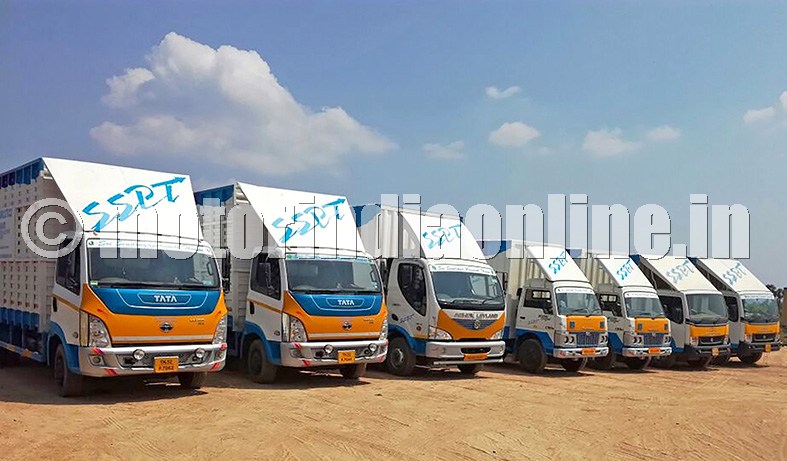SSPT Logistics, a division of Sri Sendraya Perumal Transport, was started in 2013 at Sankari in Salem district in Tamil Nadu. The company owns a fleet of 450 vehicles apart from operating 500 attached vehicles for its transport business which includes parcel services, full truck load and express cargo. SSPT’s fleet comprises 55 per cent Ashok Leyland vehicles, 20 per cent Bharath Benz trucks, 10 per cent each from Tata Motors and Mahindra and five per cent from Eicher. The South-based outfit covers all the districts of Tamil Nadu and Kerala and also does trips from the South to New Delhi, Uttar Pradesh, Rajasthan, Haryana, Uttaranchal, Punjab, and Jammu & Kashmir.

Mr. Maruthavel. P, Managing Director, SSPT Logistics, tells us about the company’s gameplan, its tech-savvy approach, expected boost from GST and more.
Excerpts:
FY17 highlights
In order to achieve our targets we had identified the business potential in Tamil Nadu and Kerala in FY17. For complete utilization of vehicles we had started parcel services to cover the entire Tamil Nadu and Kerala region in addition to which we opened 28 branches at Tamil Nadu and 22 branches at Kerala which has helped us operate our vehicles to their optimum level and achieve our targets.
Plans and outlook for FY18
In the first couple of months of FY18, we have grown our business by focusing on corporate clients. In addition, we are planning to extend our logistics services from south India to Andra Pradesh and Gujarat, making us one of the leading logistics service providers in the country.
GST impact on logistics sector
So far, the logistics players in India have been maintaining multiple warehouses across states to avoid CST levy and State entry taxes. However, once GST sees the light of the day, most of the current challenges will be a story of the past as India will become one single market wherein goods can move freely inter-State without any levy.
The implementation of GST is expected to trim the logistic costs by up to 20 per cent from the current levels; however, the persisting high logistic costs could only be resolved by improving the logistics infrastructure.
The planned dual GST model (Central GST and State GST) proposes to replace around 29 State and federal taxes and tariffs for a single tax at the point of sale. The current combined Centre and State statutory rate for most goods works out to be 26.5% (Cenvat of 14%, and VAT of 12.5%), whereas post GST implementation the same is expected to reduce to standard rate of about 18 to 21% which will be levied on most goods and all services.
On a holistic view, the implementation of GST would help us in improving the operational efficiency thus cutting the logistic cost and expanding the business prospects through consolidation of logistic players.
Technology adoption
Our vehicles are equipped with GPS facility which gives us real-time tracking information. This function enables us in driver management, speed management, fuel management and safety management. It also allows us to remove the risks associated with the vehicle investment, improving efficiency, productivity which results in reducing our overall transportation cost.
Internet of Things (IoT) will be able to provide highly integrated ‘Transportation and Warehouse Management Solutions’ connecting in-vehicle sensors and other integrated devices over the network. Embedded sensors in transport vehicles, containers will continuously capture, share and act on real-time data.
Tackling driver shortage
The driver shortage is worrisome but the industry is changing. Here we treat drivers as the vehicle owner where they take initiatives to identify potential load for transport with maximum profit from market, thereby getting a share of profit from the total trip. This freedom offers them to take decisions and that takes us to greater heights as a company.
The existing driver shortage issue is a call to the industry to re-evaluate where we are today and how the situation can be molded to bring in more drivers to meet shippers’ expectations.
Factors that would drive logistics sector growth
* The logistics sector is growing at a rate of 10 per cent per annum. Several factors are helping the growth of logistics industry in India over the decade including changing tax system, rapid growth in industries such as automobile, pharmaceuticals, FMCG and retail.
* Secondly, with India being the next manufacturing hub, increase in trade with Asia, Europe, and North America will promote an increase in demand for logistics services.
* The introduction of Value Added Tax (VAT) and the Goods and Services Tax (GST) are expected to significantly reduce the number of warehouses in different states, thereby resulting in a substantial increase in demand for integrated logistics solutions.
